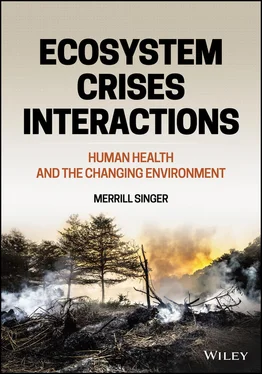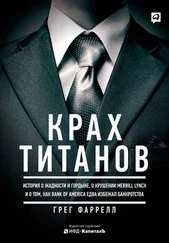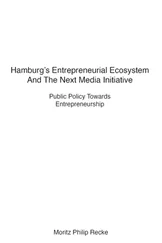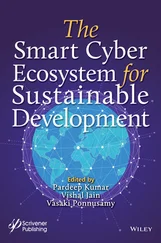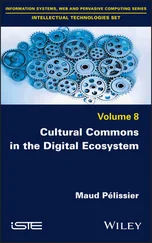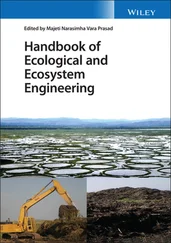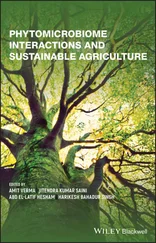1 ...8 9 10 12 13 14 ...29
1.7 Thresholds in the environment
Like pollution, other forms of anthropogenic environment disruption are not inevitable, unavoidable, or too costly to avoid. The full costs of pollution and disruption are manifest in ecocrises interactions. Critical to the development of many ecocrises interactions is the crossing of the thresholds of planetary boundaries. Environmental conditions are defined as intrinsic features at local, regional, or global scales that constitute positions along one or more control variables, such as temperature and the albedo (solar reflection) feedback pathway involving floating sea ice. Icebergs in the ocean, being lighter in color than the surrounding water, reflect more solar radiation. Consequently, the significant rate at which sea ice is melting—a phenomenon driven by planetary warming—represents a negative feedback loop that feeds further warming. Once the volume of sea ice threshold is passed, environmental degradation will continue even without further human input, reducing the possibility for mitigation. Staying within such thresholds, as a result, is critical for human well‐being and the well‐being of the other lifeforms we depend upon and with which we share this planet.
On July 28, 2000, the U.N. Economic and Social Council established the Permanent Forum on Indigenous Issues to discuss and advise on issues facing indigenous peoples of the world related to social development, culture, environment, education, health, and human rights. Nine years later, on May 27, 2009, during the eighth meeting of the Permanent Forum in New York, one of the speakers was Nicolas Lucas Ticum, a priest and researcher from Guatemala of Maya ancestry. In seeking to reframe the human/environment relationship, Ticum stated: “All of humanity must work together to re‐establish harmony and unity with the natural environment … The Earth does not belong to human beings. Human beings belong to the Earth” (Economic and Social Council 2009). The alternative is ever more devastating anthropogenic ecocrises.
1.8 Sustainability of human life on Earth
Ultimately, ecocrises threaten the sustainability of human life on Earth. Already, research suggests that Earth may be in the midst of its sixth mass extinction of species, in no small part because of the human reshaping of the environment. At this point in our history, the idea of pristine environments untouched by our presence is an illusion. We have left an indelible impression everywhere on the planet; there are no hidden natural sanctuaries that are unsullied by the effects of human society and activity. Archeological, paleoecological, and genetic research suggests that:
As our planet experiences its sixth “mass extinction event” … the effect of anthropogenic landscape modification, habitat fragmentation, overexploitation, and species invasions could not be more apparent … These transformations are linked largely to the industrial economies, burgeoning populations, and dense transport networks of contemporary human societies.
(Boivan et al . 2016)
In fact, Boivan et al . (2016) stress, the human‐mediated alteration of Earth long predates the rise of industrial economies. Relative to our impact on other species, they identify four pivotal phases in the loss of pristinity: 1) the Late Pleistocene near‐global dispersal of our ancestors; 2) the emergence and spread of agriculture and livestock domestication beginning in the Early Holocene; 3) the human colonization of the world’s islands; and 4) the premodern expansion of urbanization and trade beginning 5000 years ago during the Bronze Age. While socioeconomic developments since the Bronze Age have dramatically accelerated the magnitude and range of the human impact, all of these prior moments in the making of a human‐dominated Earth are significant.
A significant biological effect of the Late Pleistocene expansion of our species, for example, was felt by larger animals or megafauna, those weighing over 100 pounds. While there is debate concerning the extent of the human role in the extinction of about 90 megafauna genera in the period between 50 000 and 10 000 years ago (Koch & Barnosly 2006), new analytic approaches affirm at least some direct human role through hunting in the disappearance of animals like the giant ground sloth, woolly mammoth, saber‐tooth cat, a giant 6‐foot‐long beaver, and the 3‐ton Diprotodon, the largest marsupial that ever lived. This research suggests an inverse relationship between the severity of the extinction and the duration of hominin–megafauna contact.
If hunting only partly accounts for the megafauna extinctions, what else was involved? According to Koch & Barnosky (2006, p. 239):
Taken as a whole, recent studies suggest that humans precipitated the extinction in many parts of the globe through combined direct (hunting) and perhaps indirect (competition [for food or habitat], habitat alteration and fragmentation) impacts, but that … environmental change influenced the timing, geography, and perhaps magnitude of extinction. Put another way, absent the various impacts of Homo sapiens … it is highly unlikely global ecosystems would have experienced a mass extinction of large, slow‐breeding animals in the late Quaternary. But, absent concurrent rapid climatic change evident in many parts of the globe, some species may have persisted longer.
In other words, it is likely that it was the interaction of human hunting and climate change that eliminated or fragmented the environmental conditions necessary to maintain the megafauna, leading to their extinction.
Without question, the vast majority (99 percent) of species that have ever lived are now extinct (Novacek 2001). Human presence on the planet is not guaranteed; indeed, like all species, and despite our comparatively big brains and powerful technologies, we are dependent upon our fragile relationship with the environment. Failure to fully appreciate this simple truth and move with determination to more sustainable socioeconomic systems will place our near future at grave risk. This idea touches on a broader question about lifeforms elsewhere in our galaxy: namely, why, with all of our searching (e.g., NASA probes, monitoring of electromagnetic radiation, the work of the SETI Institute), have we not encountered signs of alien civilizations? One explanation, known as the Great Filter theory, is that extraterrestrial civilizations may emerge, develop, and destroy their environments, and hence themselves, too quickly for us to find them, or vice versa. In other words, the Milky Way may be sprinkled with extinct alien civilizations that were wiped out by self‐induced environmental destruction.
1.9 How did things get this bad?
Promoting the vital need to develop a deeper awareness of our relationship with the environment and assisting students to make informed decisions for action are the ultimate objectives of this book. While there is mounting concern over the ways anthropogenic environmental change is putting human health at risk, the specific rationale for this volume is the inadequate consideration given to the special risk of ecocrises interaction in the existing environmental literature.
The following chapters trace the history of that risk, beginning with the sweeping environmental and social changes launched by the Industrial Revolution. These changes were so immense that many environmental scientists see them as constituting a new geological epoch, one that highlights the dominant role now played by human activity in shaping the very geology and ecology of Earth. Referred to as the Anthropocene, it was triggered in the late eighteenth century with the invention of the steam engine, followed in relatively short order by the production and use of fossil fuels, which contributed to an intense rise in the amount of carbon dioxide and other pollutants in the atmosphere and the oceans. Industrial production, in turn, contributed to an array of other environmental crises, including fuel spills, waste dumping and leakages ( Fig. 1.4), deforestation, the spread of infectious diseases, loss of biodiversity, and the devastation of marine life.
Читать дальше
